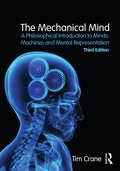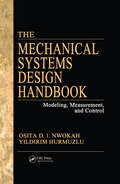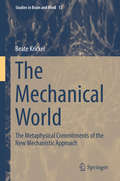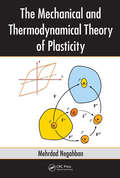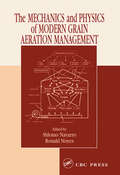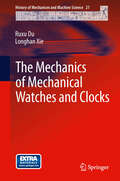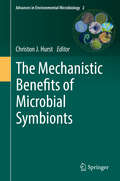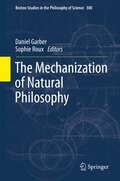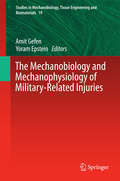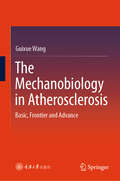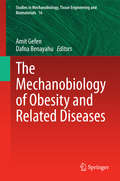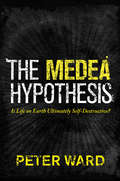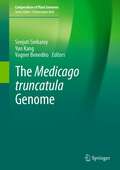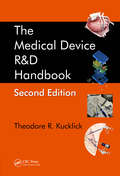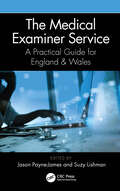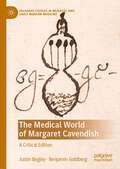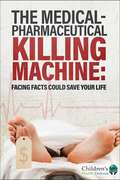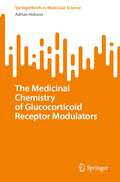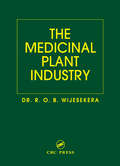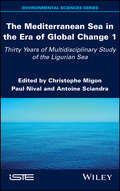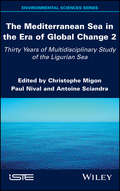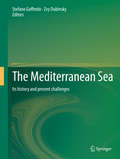- Table View
- List View
The Mechanical Mind: A Philosophical Introduction to Minds, Machines and Mental Representation
by Tim CraneHow can the human mind represent the external world? What is thought, and can it be studied scientifically? Should we think of the mind as a kind of machine? Is the mind a computer? Can a computer think? Tim Crane sets out to answer these questions and more in a lively and straightforward way, presuming no prior knowledge of philosophy or related disciplines. Since its first publication, The Mechanical Mind has introduced thousands of people to some of the most important ideas in contemporary philosophy of mind. Crane explains the fundamental ideas that cut across philosophy of mind, artificial intelligence and cognitive science: what the mind-body problem is; what a computer is and how it works; what thoughts are and how computers and minds might have them. He examines different theories of the mind from dualist to eliminativist, and questions whether there can be thought without language and whether the mind is subject to the same causal laws as natural phenomena. The result is a fascinating exploration of the theories and arguments surrounding the notions of thought and representation. This third edition has been fully revised and updated, and includes a wholly new chapter on externalism about mental content and the extended and embodied mind. There is a stronger emphasis on the environmental and bodily context in which thought occurs. Many chapters have been reorganised to make the reader's passage through the book easier. The book now contains a much more detailed guide to further reading, and the chronology and the glossary of technical terms have also been updated. The Mechanical Mind is accessible to anyone interested in the mechanisms of our minds, and essential reading for those studying philosophy of mind, philosophy of psychology, or cognitive psychology.
The Mechanical Systems Design Handbook: Modeling, Measurement, and Control (Electrical Engineering Handbook)
by Osita D. I. Nwokah Yildirim HurmuzluWith a specific focus on the needs of the designers and engineers in industrial settings, The Mechanical Systems Design Handbook: Modeling, Measurement, and Control presents a practical overview of basic issues associated with design and control of mechanical systems. In four sections, each edited by a renowned expert, this book answers diverse questions fundamental to the successful design and implementation of mechanical systems in a variety of applications.Manufacturing addresses design and control issues related to manufacturing systems. From fundamental design principles to control of discrete events, machine tools, and machining operations to polymer processing and precision manufacturing systems.Vibration Control explores a range of topics related to active vibration control, including piezoelectric networks, the boundary control method, and semi-active suspension systems.Aerospace Systems presents a detailed analysis of the mechanics and dynamics of tensegrity structuresRobotics offers encyclopedic coverage of the control and design of robotic systems, including kinematics, dynamics, soft-computing techniques, and teleoperation.Mechanical systems designers and engineers have few resources dedicated to their particular and often unique problems. The Mechanical Systems Design Handbook clearly shows how theory applies to real world challenges and will be a welcomed and valuable addition to your library.
The Mechanical Universe: Mechanics and Heat, Advanced Edition
by David L. Goodstein Steven C. Frautschi Richard P. Olenick Tom M. ApostolThis innovative physics textbook intended for science and engineering majors develops classical mechanics from a historical perspective. The presentation of the standard course material includes a discussion of the thought processes of the discoverers and a description of the methods by which they arrived at their theories. However the presentation proceeds logically rather than strictly chronologically, so new concepts are introduced at the natural moment. The book assumes a familiarity with calculus, includes a discussion of rigid body motion, and contains numerous thought-provoking problems. It is largely based in content on The Mechanical Universe: Introduction to Mechanics and Heat, a book designed in conjunction with a tele-course to be offered by PBS in the Fall of 1985. The advanced edition, however, does not coincide exactly with the video lessons, contains additional material, and develops the fundamental ideas introduced in the lower-level edition to a greater degree.
The Mechanical World: The Metaphysical Commitments of the New Mechanistic Approach (Studies in Brain and Mind #13)
by Beate KrickelThis monograph examines the metaphysical commitments of the new mechanistic philosophy, a way of thinking that has returned to center stage. It challenges a variant of reductionism with regard to higher-level phenomena, which has crystallized as a default position among these so-called New Mechanists. Furthermore, it opposes those philosophers who reject the possibility of interlevel causation. Contemporary philosophers believe that the explanation of scientific phenomena requires the discovery of relevant mechanisms. As a result, new mechanists are, in the main, concerned solely with epistemological questions. But, the author argues, their most central claims rely on metaphysical assumptions. Thus, they must also take into account metaphysics, a system of thought concerned with explaining the fundamental nature of being and the world around it. This branch of philosophy does indeed matter to the empirical sciences. The chapters investigate the nature of mechanisms, their components, and the ways in which they can bring about different phenomena. In addition, the author develops a novel account of causation in terms of activities. The analysis provides the basis for many further research projects on mechanisms and their relations to, for example, the mind-body problem, realization, multiple realization, natural kinds, causation, laws of nature, counterfactuals, and scientific levels.
The Mechanical and Thermodynamical Theory of Plasticity
by Mehrdad NegahbanBorn out of 15 years of courses and lectures on continuum mechanics, nonlinear mechanics, continuum thermodynamics, viscoelasticity, plasticity, crystal plasticity, and thermodynamic plasticity, The Mechanical and Thermodynamical Theory of Plasticity represents one of the most extensive and in-depth treatises on the mechanical and thermodynamical a
The Mechanics and Physics of Modern Grain Aeration Management
by Shlomo Navarro Ronald NoyesThe tightening of health and environmental regulations by banning chemical pesticides has generated the need for alternative technologies to solve grain storage problems. Aeration is such an option that can be applied to stored grain and a wide range of agricultural commodities to control insects and maintain quality. The Mechanics and Physics of M
The Mechanics of Mechanical Watches and Clocks
by Longhan Xie Ruxu Du"The Mechanics of Mechanical Watches and Clocks" presents historical views and mathematical models of mechanical watches and clocks. Although now over six hundred years old, mechanical watches and clocks are still popular luxury items that fascinate many people around the world. However few have examined the theory of how they work as presented in this book. The illustrations and computer animations are unique and have never been published before. It will be of significant interest to researchers in mechanical engineering, watchmakers and clockmakers, as well as people who have an engineering background and are interested in mechanical watches and clocks. It will also inspire people in other fields of science and technology, such as mechanical engineering and electronics engineering, to advance their designs. Professor Ruxu Du works at the Chinese University of Hong Kong, China. Assistant Professor Longhan Xie works at the South China University of Technology, China.
The Mechanistic Benefits of Microbial Symbionts
by Christon J. HurstThisvolume summarizes recent advances in our understanding of the mechanisms that producesuccessful symbiotic partnerships involving microorganisms. It begins with abasic introduction to the nature of and mechanistic benefits derived from symbioticassociations. Taking that backgroundknowledge as the starting point, the next sections include chapters that examinerepresentative examples of coevolutionary associations that have developed betweenspecies of microbes, as well as associations between microbes and plants. The authors conclude with a section covering abroad range of associations between microbes and invertebrate animals, in whichthey discuss the spectrum of hosts, with examples ranging from bryozoans andcorals to nematodes, arthropods, and cephalopods. Join the authors on thisjourney of understanding!
The Mechanization of Natural Philosophy
by Dan Garber Sophie RouxThe Mechanisation of Natural Philosophy is devoted to various aspects of the transformation of natural philosophy during the 16th and 17th centuries that is usually described as mechanical philosophy .Drawing the border between the old Aristotelianism and the « new » mechanical philosophy faces historians with a delicate task, if not an impossible mission. There were many natural philosophers who actually crossed the border between the two worlds, and, inside each of these worlds, there was a vast spectrum of doctrines, arguments and intellectual practices. The expression mechanical philosophy is burdened with ambiguities. It may refer to at least three different enterprises: a description of nature in mathematical terms; the comparison of natural phenomena to existing or imaginary machines; the use in natural philosophy of mechanical analogies, i.e. analogies conceived in terms of matter and motion alone.However mechanical philosophy is defined, its ambition was greater than its real successes. There were few mathematisations of phenomena. The machines of mechanical philosophers were not only imaginary, but had little to do with the machines of mecanicians. In most of the natural sciences, analogies in terms of matter and motion alone failed to provide satisfactory accounts of phenomena.By the same authors: Mechanics and Natural Philosophy before the Scientific Revolution (Boston Studies in the Philosophy of Science 254).
The Mechanobiology and Mechanophysiology of Military-Related Injuries
by Amit Gefen Yoram EpsteinThis book provides a state-of-the-art update, as well as perspectives on future directions of research and clinical applications in the implementation of biomechanical and biophysical experimental, theoretical and computational models which are relevant to military medicine. Such experimental and modeling efforts are helpful, on the one hand, in understanding the aetiology, pathophysiology and dynamics of injury development and on the other hand in guiding the development of better equipment and protective gear or devices that should ultimately reduce the prevalence and incidence of injuries or lessen their hazardous effects. The book is useful for military-oriented biomedical engineers and medical physicists, as well as for military physiologists and other medical specialists who are interested in the science and technology implemented in modern investigations of military related injuries.
The Mechanobiology in Atherosclerosis: Basic, Frontier and Advance
by Guixue WangThis book is based on prior research conducted by the author's team, integrating the latest advancements in biomechanics and mechanobiology related to atherosclerosis from both domestic and international peers. It explores the mechanobiological mechanisms and prevention strategies for atherosclerosis and intravascular stent restenosis. The topics covered include: lipoprotein concentration polarization, stress response of vascular endothelial cells, biomechanical mechanisms in cardiovascular and cerebrovascular development, atherosclerotic plaque formation, in-stent restenosis, and post-stent implantation atherosclerosis. Additionally, the book presents the mechanobiological mechanisms of drug regulation for cell viability and inhibition of vascular restenosis, as well as the latest frontiers and advancements in these areas. It carries significant reference value for postgraduates and young researchers in cardiovascular physiology and pathology, particularly those involved in biomedical engineering, basic medicine, and clinical medicine focused on atherosclerotic disease research.
The Mechanobiology of Obesity and Related Diseases
by Amit Gefen Dafna BenayahuThis volume describes the state-of-knowledge in the study of the relationships between mechanical loading states in tissues and common pathophysiologies related to increase in mass of adipose tissues and/or hyperglycemia which eventually lead to obesity, diabetes, insulin resistance, hyperlipidemia, metabolic inflammations, certain types of cancer and other related diseases. There appears to be an interaction between the loading states in tissues and cells and these chronic conditions, as well as with factors such as age, gender and genetics of the individual. Bioengineering has made key contributions to this research field in providing technologies for cell biomechanics experimentation, microscopy and image processing, tissue engineering and multi-scale, multi-physics computational modeling. Topics at the frontier of this field of study include: the continuous monitoring of cell growth, proliferation and differentiation in response to mechanical factors such as stiffness of the extracellular matrix (ECM) and mechanical loads transferred through the ECM; mechanically-activated signaling pathways and molecular mechanisms; effects of different loading regimes and mechanical environments on differentiation fates of mesenchymal stem cells (MSCs) into myogenic and osteogenic versus adipogenic lineages; the interactions between nutrition and mechanotransduction; cell morphology, focal adhesion patterns and cytoskeletal remodeling changes in adipogenesis; activation of receptors related to diabetes by mechanical forces; brown and white adipose plasticity and its regulation by mechanical factors.
The Medea Hypothesis: Is Life on Earth Ultimately Self-Destructive?
by Peter WardIn The Medea Hypothesis, renowned paleontologist Peter Ward proposes a revolutionary and provocative vision of life's relationship with the Earth's biosphere--one that has frightening implications for our future, yet also offers hope. Using the latest discoveries from the geological record, he argues that life might be its own worst enemy. This stands in stark contrast to James Lovelock's Gaia hypothesis--the idea that life sustains habitable conditions on Earth. In answer to Gaia, which draws on the idea of the "good mother" who nurtures life, Ward invokes Medea, the mythical mother who killed her own children. Could life by its very nature threaten its own existence? According to the Medea hypothesis, it does. Ward demonstrates that all but one of the mass extinctions that have struck Earth were caused by life itself. He looks at our planet's history in a new way, revealing an Earth that is witnessing an alarming decline of diversity and biomass--a decline brought on by life's own "biocidal" tendencies. And the Medea hypothesis applies not just to our planet--its dire prognosis extends to all potential life in the universe. Yet life on Earth doesn't have to be lethal. Ward shows why, but warns that our time is running out. Breathtaking in scope, The Medea Hypothesis is certain to arouse fierce debate and radically transform our worldview. It serves as an urgent challenge to all of us to think in new ways if we hope to save ourselves from ourselves.
The Medicago truncatula Genome (Compendium of Plant Genomes)
by Senjuti Sinharoy Yun Kang Vagner BeneditoThis book focuses on the discoveries in M. truncatula genomic research which has been undertaken in the last two decades. Legumes are important for their economic values as food, feed, and fodder and also serve as the pillar of sustainable agriculture because of its biological nitrogen fixation capacity. Medicago truncatula was established as a model legume in the 1990s and has been well adopted as a model internationally since then. M. truncatula is an autogamous, diploid (2n = 16) species with a short generation time, and relatively small genome size (~375 Mbp). The M. truncatula genome was initially sequenced by the International Medicago Genome Annotation Group (IMGAG) in 2011 and has been well-annotated. M. truncatula research benefits from the availability of several genetic and genomic tools, such as gene expression atlas (MtGEA), insertion and neutron bombardment mutant populations, and a HapMap panel containing 384 sequenced inbred lines for genome-wide association studies. This book covers the current status and latest advancements of the M. truncatula genomics and transcriptomics resources along with a glimpse of newly developed tools that makes M. truncatula a front runner model in functional genomic studies.
The Medical Device R&D Handbook
by Theodore R. KucklickExploring the practical, entrepreneurial, and historical aspects of medical device development, this second edition of The Medical Device R&D Handbook provides a how-to guide for medical device product development. The book offers knowledge of practical skills such as prototyping, plastics selection, and catheter construction, allowing designer
The Medical Examiner Service: A Practical Guide for England and Wales
by Jason Payne-James Suzy LishmanThis book provides a practical guide for all those working in or with Medical Examiner Services in England and Wales. It is an adjunct to the e-learning and face-to-face training required to fulfil the Medical Examiner and Medical Examiner Officer roles. Medical Examiner Services also work closely with a wide range of stakeholders including bereavement and mortuary teams, Coroners and their Officers, Registrars, Funeral Directors and those working in clinical governance and patient safety. This book provides an essential overview of all aspects of the Medical Examiner system for anyone working in these areas, or in any aspect of the support and management of the deceased and bereaved. A concise guide including the knowledge base required to develop and run a Medical Examiner Service Content is completely aligned with required training Written by those with direct experience of establishing and working with Medical Examiner Services Relevant to a wide range of stakeholders who work with patients and the bereaved
The Medical World of Margaret Cavendish: A Critical Edition (Palgrave Studies in Medieval and Early Modern Medicine)
by Benjamin Goldberg Justin BegleyThis book is the first transcription and extensive commentary on a fascinating but almost entirely overlooked manuscript compilation of medical recipes and letters, which is held in the University of Nottingham. Collected by the Marquess and Marchioness of Newcastle, William and Margaret Cavendish, during the 1640s and 1650s, this manuscript features letters of advice, recipes, and sundry philosophical and medical reflections by some of the most formidable and influential physicians, philosophers, and courtly scholars of the early seventeenth century. These include “Europe’s physician” Theodore de Mayerne, the adventurer and courtier Kenelm Digby, and the natural philosopher, poet, and playwright Margaret Cavendish. While the transcription and accompanying annotations will allow a diverse array of readers to appreciate the manuscript for the first time, the introduction situates the Cavendishes’ recipe collecting habits, medical preoccupations, natural philosophical views, and politics within their social, cultural, and philosophical contexts, and draws out some of the most significant implications of this important document.
The Medical-Pharmaceutical Killing Machine: Facing Facts Could Save Your Life
by Children's Health DefenseMedical and pharmaceutical history is replete with examples of dangerous interventions that have poisoned, injured, or killed. However, events since 2020 have attracted attention as never before to medicine&’s potential to be both lethal and malevolent. In The Medical-Pharmaceutical Killing Machine, Children&’s Health Defense situates current perils in their broader context with the aim of helping readers understand how to protect themselves and their loved ones. In the Greek Trojan War saga, the god Apollo ensured that Cassandra&’s prophecies would never be believed, with disastrous consequences. As recounted in the book, modern medicine, too, has produced its fair share of &“medical Cassandras&”—doctors and writers who have tried to warn the public about medicine&’s life-threatening underbelly, generally to little avail. A chapter dedicated to nine of these medical skeptics, beginning with Ivan Illich and his coining of the term &“iatrogenesis&” to describe adverse outcomes caused by doctors, weaves a powerful portrait of harms regularly denied and ignored, with those making the claims typically marginalized and &“canceled.&” The book shows that there is no shortage of tools in the killing machine arsenal. One chapter highlights the mRNA vaccine technology inaugurated with COVID, illustrating how this new mechanism for iatrogenesis is inflicting novel forms of toxicity, not all of which are yet understood. Another chapter about assisted suicide and euthanasia describes the chilling global proliferation of policies and propaganda promoting those practices for vulnerable populations that include babies, children, people diagnosed with autism, and the mentally ill. The book also describes factors that make it possible for the killing machine to continue operating with impunity, including the ascendance of an &“evidence-based medicine&” juggernaut, medical gaslighting, and a ballooning global enforcement infrastructure. Nor does it shy away from confronting what some now characterize as &“iatrogenocide&”; a chapter asking &“Why Do They Do It?&” considers money, prestige, and control as three possible answers. Ultimately, it is only by acknowledging the long-standing reality of an all-too-effective medical-pharmaceutical killing machine that people can learn to dodge the threats and work toward building a different model that prioritizes life and genuine health.
The Medicinal Chemistry of Glucocorticoid Receptor Modulators (SpringerBriefs in Molecular Science)
by Adrian HobsonThis book covers the design and development of glucocorticoid receptor modulators (GRM) from cortisol to antibody-drug conjugate payloads over the last 70 years. The author starts with an introduction to the background of glucocorticoid receptor modulators as potential therapeutic modalities. This is followed by seven chapters in which he collates and discusses the medicinal chemistry journey of GRMs, reviewing topics such as cortisol-based glucocorticoids, the different approaches that have been pursued to enable chronic dosing of GRM compounds by inactivation in plasma and the liver, the application of prodrugs to GRMs, selective GRMs, targeted delivery of GRMs using polymers and nanoparticles, and rational drug design approaches applied in the development of GRMs. Particular attention is given to the development of glucocorticoid receptor modulators as immunology antibody-drug conjugate payloads. In the book’s final chapter, the author critiques the medicinal chemistry progress made since the discovery of cortisone and the promise of the latest antibody-drug conjugates that release a GRM payload. In this book, readers will also find an overview of the X-ray structures of glucocorticoid receptor antagonists and a list of all the earlier reviews that cover part of the medicinal chemistry story of GRM collated by keywords organized in a table. With several examples of crystal structures and molecular modeling, this book illustrates the huge effort by multiple companies and research groups to develop glucocorticoid receptor modulators. Professionals and scholars alike will find it a handy tool, and appreciate the latest research findings that it presents.
The Medicinal Plant Industry
by R. O. WijesekeraAs the medicinal plant industry blooms into a billion dollar business, it reaches beyond collection, propagation, harvesting and sale of crude vegetal drugs into product formulation, packaging and dispensing of sophisticated phyto-pharmaceuticals and herbal preparations. The scientific study of these medicines and the systematic uplifting of the industry to preserve the ancient and serve the modern, is now a global challenge.The Medicinal Plant Industry puts together the various facets of this multi-disciplinary industry and its global interest. It discusses the dire need for developing countries to acquire technologies and techniques for programmed cultivation of medicinal plants. It addresses a wide variety of topics including the old philosophies, modern impact of traditional medicines, and methods of assessing the spontaneous flora for industrial utilization. It covers aspects of cultivation and climatic variations, biological assessment and formulation, process technologies, phytochemical research and information sources. The book reviews highly developed traditional medicine in China and India, and covers experiences in Africa and other continents.
The Medicine Show: Consumer Union's Practical Guide to some Everyday Health Problems and Health Products
by The Editors of Consumer ReportsMedical advice on common health problems, facts about popular brand-name remedies, advice on buying prescription drugs, choosing a doctor and a hospital, what to have (and not have) in your medicine cabinet
The Mediterranean Diet
by Eric ZachariasOver the past several years there has been increasing information in the medical literature regarding the health benefits of a Mediterranean diet. Clinicians may not be informed on advances in nutrition, and studies have demonstrated that they do not spend much time discussing food as a means for promoting health with patients. The Mediterranean Diet: A Clinician's Guide for Patient Care is an essential new volume that serves as an update and a reference for clinicians on the Mediterranean diet. Specific diseases and the effects the Mediterranean diet have on them are outlined. Diseases and conditions that are outlined include heart disease, stroke, Alzheimer's, depression, cancer, allergies, asthma, arthritis and diabetes. A detailed analysis of the specific nutrients in a Mediterranean diet and the food groups containing them is also included. A useful guide containing daily meal plans and and an extensive recipe section prepared by a team of dieticians can be found in the patient resources section. The Mediterranean Diet: A Clinician's Guide for Patient Care provides a useful summary of the constituent components and health benefits of a Mediterranean diet to health professionals.
The Mediterranean Sea in the Era of Global Change 1: 30 years of Multidisciplinary Study of the Ligurian Sea
by Christophe Migon Paul Nival Antoine SciandraDue to its particular characteristics, the Mediterranean Sea is often viewed as a microcosm of the World Ocean. Its proportionally-reduced dimensions and peculiar hydrological circulation render it susceptible to environmental and climatic constraints, which are rapidly evolving. The Mediterranean is therefore an ideal site to examine, in order to better understand a number of key oceanographic phenomena. This is especially true of the Ligurian Sea where, due to its geology, oceanic conditions are found close to the coast. As such, 30 years ago, an offshore time-series site provided a fresh impetus to a long history of marine biology research, which has generated a very important body of data and knowledge. This is the first volume, in a two-volume series, that summarizes this research. Across these two books, the reader will find 13 chapters that examine the geology, physics, chemistry and biology of the Ligurian Sea ? always with the goal of providing key elements of oceanography in a changing world.
The Mediterranean Sea in the Era of Global Change 2: 30 Years of Multidisciplinary Study of the Ligurian Sea
by Christophe Migon Paul Nival Antoine SciandraDue to its particular characteristics, the Mediterranean Sea is often viewed as a microcosm of the World Ocean. Its proportionally-reduced dimensions and peculiar hydrological circulation render it susceptible to environmental and climatic constraints, which are rapidly evolving. The Mediterranean is therefore an ideal site to examine, in order to better understand a number of key oceanographic phenomena. This is especially true of the Ligurian Sea where, due to its geology, oceanic conditions are found close to the coast. As such, 30 years ago, an offshore time-series site provided a fresh impetus to a long history of marine biology research, which has generated a very important body of data and knowledge. This is the second volume, in a two-volume series, that summarizes this research. Across these two books, the reader will find 13 chapters that examine the geology, physics, chemistry and biology of the Ligurian Sea ? always with the goal of providing key elements of oceanography in a changing world.
The Mediterranean Sea: Its history and present challenges
by Zvy Dubinsky Stefano GoffredoThis volume is an indispensable addition to the multidisciplinary coverage of the science of the Mediterranean Sea. The editors have gathered leading authorities from the fields of Marine Biology, Ecology, paleoclimatology, Chemical and Physical Oceanography, Zoology, Botany, Aquatic Photosynthesis, Socioeconomics, Mariculture, Mediterranean History and Science of Humanity. Beginning with the birth of the Mediterranean Sea and its myths. From coral to fish, an introduction is given to its major inhabitants of plants and animals past and present. The chapters illustrate how organisms interact as part of the structure and function of the Sea's main ecosystems. The rise of the Mediterranean as the cradle of the Western Civilization leads to a discourse on the status of human interaction with the sea. Accelerating global climate change, water warming, ocean acidification and sea level rise, and analyses of their effects on key organisms, entire ecosystems and human socioeconomics are given. Forecasting and predictions are presented taking into account different future scenarios from the IPCC (International Panel on Climate Change). The volume is richly illustrated in color, with an extensive bibliography. A valuable addition to the limited literature in the field, offering up-to-date broad coverage merging science and humanities.
